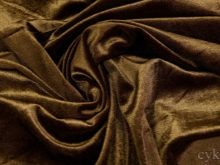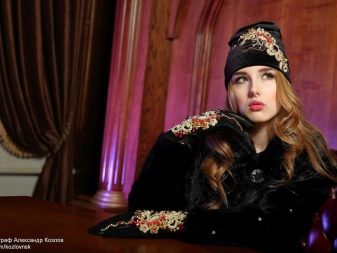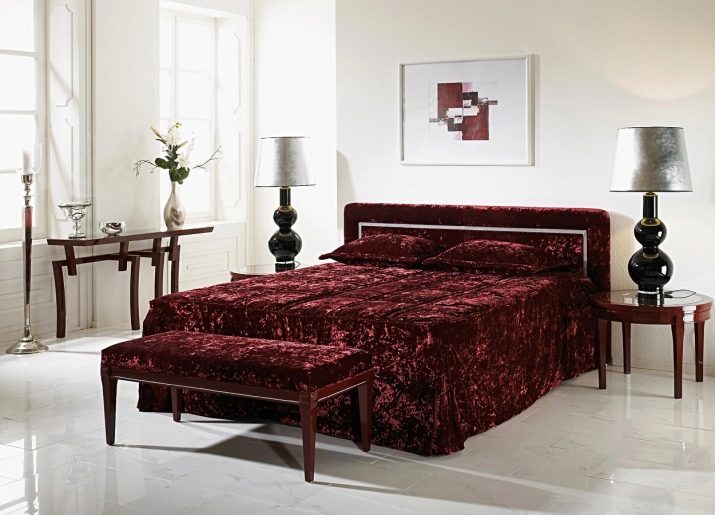Velvet: features, varieties, pros and cons

Velvet has been considered a luxury item at all times. Its manufacture is very expensive. But any thing from it - be it a work of art, clothing or furnishings - all this is considered a noble chic.
What it is?
The history of the origin of the fabric is rooted in the distant past. Velvet is a derivative of the German Barchent, which means "boomazeya". In France, this fabric was called velor, and in England, velveteen. But today all these are different types of fabrics and should not be combined with velvet.
The first descriptions of this type of fabric date back to the 11th century. This is the period of the early Middle Ages, when there were no manufacturing industries yet and all fabrics, including the rarest and most expensive, were made by hand on special machines. The characteristics and composition of the canvases of those times are distinguished by a special technology that most likely came from the Ancient East. It was there that all types of silk-based fabrics were first produced. Through the Silk Road, these fabrics, and then the technology of their production, came to other countries.
In Europe, this type of fabric was produced exclusively by the weavers' guild. In the 13th century, she moved to Italy, where she has established herself to this day. Weavers belonged to a privileged class, they were included in the royal palaces. Quite often the manufacturers of velvet equipped entire caravans of ships for trade with other countries. They were rich well-to-do people. Still would! After all, the noble fabric was supplied to the court of the king himself.



Only the richest merchants and nobles of that time could sew clothes from it. These were velvet robes, hats, shoes and accessories adorned with precious stones and metals.The scattering of pearls on the purple velvet adornments of the royal nobility was a sign of their noble origin. Queen Elizabeth and King Karl are depicted by medieval artists in expensive dresses with robes made of noble velvet.
Velvet fabric is still considered one of the most expensive in the world. Over the centuries, little has changed in its production. It is still made from silk threads. New technologies make it possible to produce velvet based on synthetic materials, as well as with the addition of organic fiber, viscose and wool.
Currently, there are two ways to produce pile fabrics.
The slitting method consists in the fact that the fabric base of two canvases is fastened by cutting the fibrous bonds. Formed a smooth seamy part and "terry" - front.
The looping method is obtained by pulling the loops from a knitted fabric base and then cutting them. The result is a characteristic structural iridescent surface.


Velvet fabric, obtained by any of the described methods, is dyed and decorated with embroidery, embossing is performed, and a drawing or ornament is also stuffed. Velvet fibers are mixed with the pile of fabrics of various structures. This is how suede is obtained - artificial leather; velor is an analogue of leather, soft on one side and smooth on the other; plush is a material with a shaggy long pile, velveteen is a fabric with a fleecy rib.
Accessories and clothing, household items and home textiles are made of velvet: decorative pillows, stoles, curtains and tablecloths, canopies and bedspreads, as well as upholstery and decorations. In jewelry stores, jewelry is laid out on a velvet base, as this material gently reflects light, emphasizing the advantages of jewelry made of gold, silver or platinum.
In the theater and film industry, velvet material plays an important role in the creation of historical images. Costumes are sewn from it and the decor is formed.



Views
Velvet fabric is one-sided - with a pile located only on the front side, and two-sided - when there is a pile on both sides, with stretch threads, as well as combined with elements of a pattern or ornament.
For the production of velvet fabrics, special technologies are used, thanks to which all new types of fabrics appear. The most common ones.
Velvet eraser known as corduroy. This is a natural ribbed fabric with a weft weave. The size (step) of the hem depends on the quality of the fabric, its density and the method of production.
Semi-velvet - this is the same velvet, only with sheared pile.
Velvet chiffon has a thin airy fabric structure. This includes panne velvet on silk threads with a shiny surface.
Sisal - a kind of velvet on a loop-like basis.
Bagheera - a kind of fabric with a particularly strong structure, rough to the touch. It got its name from its resemblance to the woolen skin of an animal.
Devore - also a kind of velvet fabric on a silk basis with the addition of viscose threads, allowing the production of fabric with patterns on the surface.
Lyon velvet it is distinguished by the rigid status of a fabric consisting of artificial or natural silk with the addition of cotton and synthetic threads.
Mother-of-pearl velvet belongs to the most valuable types of fabrics, as it basically contains only natural silk. Due to this, it has a distinctive name.






This is not the whole list of types of velvet. Modern developments and an innovative approach provide for the receipt of new varieties of this material.
There are so-called velvet analogues: plush fabric - a cheaper analogue based on synthetics; and velor with stretch - an elastic hygroscopic material specially designed to optimize use in sports fashion lines.
Previously, velvet fabrics only had a limited range of colors.They were often dyed purple or dark blue. Dresses, decorations and outfits of this palette we see on the canvases of historical eras of ancient times.
But today the colors of this type of fabric can be different: red, black, white, blue, green, yellow, pink or red. They all depend on the dyes and the method of staining. Manufacturers use textile colors on natural and synthetic bases, as well as dye them with polymers and new innovations in gold and silver tones.
Whatever type of fabric you use in everyday life, clothing or accessories, follow the general rules for caring for things from this type, based on its advantages and disadvantages.



Advantages
The quality of the velvet material has worked well for a long time. This material has a number of advantages, advantages and positive properties:
not electrified;
hypoallergenic;
aesthetic;
practical and easy to use;
has sound insulation properties.
After washing, the velvet does not shrink or lose its shape.


Care advice
Velvet is considered a capricious material and requires careful treatment and special care. You need to properly store and be able to clean velvet products, for this there are a number of rules based on material properties:
- To remove dust, it is enough to vacuum the products. Upholstered furniture is covered with damp gauze and cleaned with light taps. You can also do with home textiles and clothing.
- You don't need to wash velvet items often. Delicate fabrics are washed exclusively by hand in warm water with a special mild detergent. After that, they do not wring out, but put it on a terry towel to remove the water, and only then dry it, carefully spreading it out on a horizontal surface. When the fabric is dry, the clothes are hung and dried out of direct sunlight.
- When caring for things, you should avoid aggressive cleaning and detergents, as well as all kinds of sprays and conditioners. You should also not sprinkle things from this type of fabric with your favorite aromas. Essential oils, getting on clothes, are difficult to remove and over time, instead of aroma, they emit unpleasant odors.
- It is not recommended to iron velvet items. To do this, use special steamers. After that, the fabric is combed with a medium-hard brush with gentle movements in the direction of the pile.
- Velvet items must not be rolled up. This fabric does not tolerate creases and deformation. If you decide to put things for storage, then it is best to hang them on a hanger, turn them inside out and put them in a closet. In no case do not fold them in half, three or four, otherwise the threads of the fabric may simply break.
- In case of serious dirt, as well as to remove stubborn stains, it is better to dry velvet products. This way you will preserve the item for years to come.



disadvantages
Ideal for everyday use, this type of fabric is rarely used in public places. For example, in the restaurant and hotel industry, it is not applicable due to its ability to absorb dust, dirt and odors. Caring for this kind of things - upholstery, tablecloths and curtains, is always very expensive. Therefore, analogs of delicate fabrics are often used in the interior of this kind.
A feature of velvet is the ability to overload the space. Therefore, it is not used to decorate small spaces. The fabric requires a lot of space. Its qualities - to refract, dim and emphasize light - are favorably played out in halls and chamber spaces. Do not forget that this fabric, as well as things with its use, are able to visually reduce the space. A noble coating is inappropriate to use for decorating a children's room or kitchen.
Among the features of this material are the following:
high hygroscopicity: velvet quickly collects dust and dries for a long time;
loses color from the sun;
sewing things is complicated due to the difficulty in stitching elements of clothing, therefore, this material is often worked by hand or on special sewing machines (in the old days, seamstresses were engaged in this);
velvet products need a lining frame due to the wear and tear of the fabric.
If you take into account the characteristics of this material and take care of it correctly, then you can successfully use velvet products for a long time.


How is it used?
Velvet fabric is used in different ways.
Velvet makes chic curtains, curtains and curtains. Therefore, in everyday life, it is often used to create stylish interiors.
To decorate the space and create historical styles, the designers cover upholstered furniture and chairs with velvet fabrics in a single color scheme. They use the property of fabrics in complex draperies, furniture covers, wall panels and floor coverings; create jacquard patterns from velvet appliques and paintings, decorate window and door openings, arches and stylized buttresses of interior spaces.
As a stole, awning and bedspread in bedrooms. The fabric acts as a shield against light and sound to create a cozy, soothing atmosphere.
As a curtain screen for delimiting zones of space in the interior.
As a wall covering - bedspreads in the best traditions of the Baroque style.
As an element of the interior. Velvet is used to decorate lamps, sconces, figurines, pillows and bolsters, used in combination with satin, organza, taffeta and silk. They decorate such things as real works of art: beads, rhinestones and semi-precious stones, gilding. Velvet is successfully combined with silk fringe, tassels, ribbons, lace, braid and other decor.
As accessories, they mainly adhere to two directions: eclecticism and retrospective. Fashion trends are represented by accessories in the form of handbags, stoles, scarves and shoes with chic elements: velvet, satin and silk, decorated with fur, leather, suede and bugles for expensive jewelry.
The fashion lines of famous design houses such as Burberry, Lacoste, Prada, Gucci, Christian Dior, Chanel, Giorgio Armani, Versace, Colin's and others often use the velvet theme to create bright images of modern comfortable clothes. The velvet roses of Gianni Versace, which conquered the world in the 80s of the last century, still adorn the evening dresses of many American stars.






Napoleon Bonaparte was the first ruler to introduce velvet into the uniforms of his army. Camisoles a la Napoleon are still used as a basis in fashion shows and demonstrations, and they are also included in the collections of world clothing brands.
Combining velvet with stretch, they create "crinkled", pleated fabrics on a noble basis.
People do not want to part with velvet, so designers have introduced it into everyday life. Now from this fabric they sew not only chic dresses with a smell, all kinds of evening dresses and business suits, but also home clothes: pajamas, dressing gowns and slippers.
Velvet fabrics are used as an exposition at exhibitions of jewelry, bijouterie, gadgets, designer shoes and accessories.
Refined, elite, noble, elegant and at the same time practical, this type of fabric is deservedly considered an element of luxury and wealth. He will not leave anyone indifferent. Whoever touched it at least once, felt the extraordinary softness, coolness and charm of its surface and amazing structure, will not want to part with these sensations in the future.
The use of velvet in everyday life has become commonplace. Now, things made of this valuable material can be afforded not only by representatives of the royal dynasty. This material has its own character, rich history and requires a special attitude, taste and respect. Therefore, with skillful handling, it can become not only an ornament, but also a practical addition to clothing or an interior.
The use of velvet fabric requires special skills.Velvet is used as a material for sewing dresses, curtains, as well as decorative elements in the interior.



An overview of velvet fabrics is presented in the following video.








